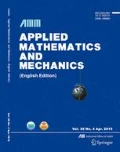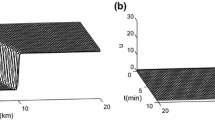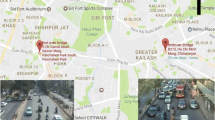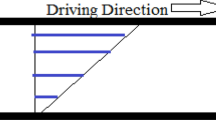Abstract
Travel time through a ring road with a total length of 80 km has been predicted by a viscoelastic traffic model (VEM), which is developed in analogous to the non-Newtonian fluid flow. The VEM expresses a traffic pressure for the unfree flow case by space headway, ensuring that the pressure can be determined by the assumption that the relevant second critical sound speed is exactly equal to the disturbance propagation speed determined by the free flow speed and the braking distance measured by the average vehicular length. The VEM assumes that the sound speed for the free flow case depends on the traffic density in some specific aspects, which ensures that it is exactly identical to the free flow speed on an empty road. To make a comparison, the open Navier-Stokes type model developed by Zhang (ZHANG, H. M. Driver memory, traffic viscosity and a viscous vehicular traffic flow model. Transp. Res. Part B, 37, 27–41 (2003)) is adopted to predict the travel time through the ring road for providing the counterpart results. When the traffic free flow speed is 80 km/h, the braking distance is supposed to be 45 m, with the jam density uniquely determined by the average length of vehicles l ≈ 5.8 m. To avoid possible singular points in travel time prediction, a distinguishing period for time averaging is pre-assigned to be 7.5 minutes. It is found that the travel time increases monotonically with the initial traffic density on the ring road. Without ramp effects, for the ring road with the initial density less than the second critical density, the travel time can be simply predicted by using the equilibrium speed. However, this simpler approach is unavailable for scenarios over the second critical.
Similar content being viewed by others
Abbreviations
- A :
-
Jacobian matrix
- B :
-
parameter used in Eq. (3)
- B 0 :
-
parameter defined by Eq. (9)
- B 1 :
-
= 2ux
- B * :
-
parameter defined by Eq. (7)
- c :
-
traffic sound speed (m/s)
- c 0 :
-
sound speed at critical density ρc2 (m/s)
- c τ :
-
speed depending on vf and xbr
- E 2 :
-
parameter defined by Eq. (22)
- F :
-
= (q, q2/ρ + p)T, flux vector
- Fi+1/2 :
-
numerical flux at xi+1/2
- G :
-
modulus of fluid elasticity used in Eq. (1)
- K :
-
model parameter used in Eq. (4)
- l :
-
average length of vehicles
- l 0 :
-
length scale (m)
- n :
-
time level
- p :
-
traffic pressure (ρmvf2)
- q :
-
= ρu, traffic flow rate (veh/s), where veh means vehiles
- q e :
-
= ρue, equilibrium traffic flow rate (veh/s)
- R :
-
defined by Eq. (13)
- R 1 :
-
= R + c2ρx
- t :
-
time (s)
- t 0 :
-
time scale (s)
- t end :
-
time of simulation ended (s)
- T tav :
-
mean travel time (s)
- T′ t :
-
root mean square (rms) of travel time (s)
- U :
-
= (ρ, q), solution vector
- u :
-
traffic speed (m/s)
- u e :
-
equilibrium traffic speed (m/s)
- u c2 :
-
second critical speed (m/s)
- v 0 :
-
speed scale (m/s)
- v f :
-
free flow speed (m/s)
- x :
-
coordinate (m)
- X br :
-
braking distance of vehicles (m)
- α :
-
= lρm, parameter used to describe traffic pressure and sound speed
- β 0 :
-
parameter used to define traffic pressure
- β :
-
= v/2τ0c02
- Δt :
-
time step (s)
- Δx :
-
mesh length (m)
- Δ0 :
-
preassigned distinguishing period (s)
- λk :
-
eigenvalues of Eq. (14)
- Λ:
-
= cτ/uc2
- ρ :
-
traffic density (kg/m3)
- ρ*:
-
first critical density (veh/km)
- ρ s :
-
saturation density (veh/km)
- ρ m :
-
traffic jam density (veh/km)
- ρ c2 :
-
second critical density (veh/km)
- ρ 0 :
-
initial density on the ring road (veh/km)
- ω :
-
=Δt/Δx, ratio of time step to spatial mesh length
- v :
-
fluid kinematic viscosity (m2/s)
- τ :
-
relaxation time (s)
- τ 0 :
-
relaxation time relevant to speed c0 (m2/s).
References
LIGHTHILL, M. J. and WHITHAM, G. B. On kinematic waves ii: a theory of traffic flow on long crowded roads. Proc. Roy. Soc. Lond A, 229, 317–345 (1955)
RICHARDS, P. I. Shock waves on the freeway. Operations Res., 4, 42–51 (1956)
PAYNE, H. J. Models of freeway traffic and control. Mathematical Model of Public Systems, Simulation Council Proc. La Jola California, 1, 51–61 (1971)
HELBING, D. and TREIBER, M. Gas-kinetic-based traffic model explaining observed hysteretic phase transition. Phys. Rev. Lett., 81, 3042–3045 (1998)
HOOGENDOORN, S. P. and BOVY, P. H. L. Continuum modeling of multiclass traffic flow. Transp. Res. Part B, 34(2), 123–146 (2000)
KERNER, B. S. and KONH¨AUSER, P. Cluster effect in initially homogemeous traffic flow. Phys. Rev. E, 48, 2335–2338 (1993)
GREENBERG, J. M. Congestion redux. SIAM J. Appl. Math., 64(4), 1175–1185 (2004)
BORSCHE, R., KIMATHI, M., and KLAR, A. A class of multi-phase traffic theories for microscopic, kinetic and continuum traffic models. Computers and Mathematics with Applications, 64, 2939–2953 (2012)
LEBACQUE, J. P., MAMMAR, S., and HAJ-SALEM, H. Generic Second Order Traffic Flow Modelling. Transportation and Traffic Theory (eds. ALLSOP, R. E. and BENJIAMIN, G. H.) Oxford, 755–776 (2007)
LEBACQUE, J. P. and KHOSHYARAN, M. M. A variational formulation for higher order macroscopic traffic flow models of the gsom family. Transp. Res. Part B, 57, 245–265 (2013)
ZHANG, P., WONG, S. C., and DAI, S. Q. A conserved higher order aniso-tropic traffic flow model: description of equilibrium and non-equilibrium flows. Transp. Res. Part B, 43(5), 562–574 (2009)
FLYNN, M. R., KASIMOV, A. R., NAVE, J. C., ROSALES, R. R., and SEIBOLD, B. Selfsustained nonlinear waves in traffic flow. Phys. Rev. E, 79, 056113 (2009)
HELBING, D. Traffic and related self-driven many-particle systems. Rev. Mod. Phys., 73, 1067–1141 (2001)
NAGATANI, T. The physics of traffic jams. Rep. Prog. Phys., 65, 1331–1386 (2002)
BRACKSTONE, M. and MCDONALD, M. Car-following: a historical review. Transp. Res. Part F, 2, 181–196 (1999)
NAGEL, K. and SCHRECKENBERG, M. A cellular automaton model for freeway traffic. J. De Phys. I, 2(12), 2221–2229 (1992)
HELBING, D. and HUBERMAN, B. A. Coherent moving states in highway traffic. nature, 396 (6713), 738–740 (1998)
CHOWDHURY, D., SANTEN, L., and SCHADSSCHNEIDER, A. Statistical physics of vehicular traffic and some related systems. Physics Reports, 329, 199–329 (2000)
NGODUY, D. Application of gas-kinetic theory to modelling mixed traffic of manual and adaptive cruise control vehicles. Transportmetrica A: Transport Science, 8(1), 43–60 (2012)
NGODUY, D. Platoon-based macroscopic model for intelligent traffic flow. Transportmetrica B: Transport Dynamics, 1(2), 153–169 (2013)
LI, J. and ZHANG, H. M. The variational formulation of a non-equilibrium traffic flow model: theory and implications. Procedia-Social and Behavioral Sciences, 80, 327–340 (2013)
ZHU, Z. J. and YANG, C. Visco-elastic traffic flow model. J. Advanced Transp., 47, 635–649 (2013)
TORDEUX, A., ROUSSIGNOL, M., LEBACQUE, J. P., and LASSARRE, S. A stochastic jump process applied to traffic flow modelling. Transportmetrica A: Transport Science, 10(4), 350–375 (2014)
COSTESEQUE, G. and LEBACQUE, J. P. A variational formulation for higher order macroscopic traffic flow models: numerical investigation. Transp. Res. Part B, 70, 112–133 (2014)
BOGDANOVA, A. I., SMIRNOVA, M. N., ZHU, Z. J., and SMIRNOV, N. N. Exploring peculiarities of traffic flows with a viscoelastic model. Transportmetrica A: Transport Science, 11(7), 561–578 (2015)
SMIRNOVA, M. N., BOGDANOVA, A. I., ZHU, Z. J., and SMIRNOV, N. N. Traffic flow sensitivity to viscoelasticity. Theoretical and Applied Mechanics Letters, 6, 182–185 (2016)
SMIRNOVA, M. N., BOGDANOVA, A. I., ZHU, Z. J., and SMIRNOV, N. N. Traffic flow sensitivity to parameters in viscoelastic modelling. Transportmetrica B: Transport Dynamics, 5(1), 115–131 (2017)
ZHANG, Y. L., SMIRNOVA, ¡. N., BOGDANOVA, A. I., ZHU, Z. J., and SMIRNOV, N. N. Travel time estimation by urgent-gentle class traffic flow model. Transp. Res. Part B, 113, 121–142 (2018)
CHANG, G. L. and MAHMASSANI, H. S. Travel time prediction and departure time adjustment behavior dynamics in a congested traffic system. Transp. Res. Part B, 22, 217–232 (1988)
DAILEY, D. J. Travel-time estimation using cross-correlation techniques. Transp. Res. Part B, 27(2), 97–107 (1993)
LINT, J. V. and DER ZIJPP, N. V. Improving a travel-time estimation algorithm by using dual loop detectors. Transp. Res. Rec., 1855, 41–48 (2003)
CHIEN, S. I. J. and KUCHIPUDI, C. M. Dynamic travel time prediction with real-time and historic data. ASCE J. Transp. Eng., 129(6), 608–616 (2003)
WU, C. H., MO, J. M., and LEE, D. T. Travel-time prediction with support vector regression. IEEE Trans. Intell. Transp. Syst., 5(4), 276–281 (2004)
VAN LINT, J. W. C., HOOGENDOORN, S. P., and VAN ZUYLEN, H. J. Accurate freeway travel time prediction with state-space neural networks under missing data. Transp. Res. Part C, 13, 347–369 (2005)
HOFLEITNER, A., HERRING, R., and BAYEN, A. Arterial travel time forecast with streaming data: a hybrid approach of flow modeling and machine learning. Transp. Res. Part B, 46, 1097–1122 (2012)
RAMEZANI, M. and GEROLIMINIS, N. On the estimation of arterial route travel time distribution with markov chains. Transp. Res. Part B, 46, 1576–1590 (2012)
JENELIUS, E. and KOUTSOPOULOS, H. N. Travel time estimation for urban road networks using low frequency probe vehicle data. Transp. Res. Part B, 53, 64–81 (2013)
YILDIRIMOGLU, M. and GEROLIMINIS, N. Experienced travel time prediction for congested freeways. Transp. Res. Part B, 53, 45–63 (2013)
HANS, E., CHIABAUT, N., and LECLERCQ, L. Applying variational theory to travel time estimation on urban arterials. Transp. Res. Part B, 78, 169–181 (2015)
KUMAR, B. A., VANAJAKSHI, L., and SUBRAMANIAN, S. C. Bus travel time prediction using a time-space discretization approach. Transp. Res. Part C, 79, 308–332 (2017)
CHANG, G. L. and MAHMASSANI, H. S. Travel time prediction and departure time adjustment behavior dynamics in a congested traffic system. Transp. Res. Part B, 22, 217–232 (1988)
MA, Z. L., KOUTSOPOULOS, H. N., FERREIRA, L., and MESBAH, M. Estimation of trip travel time distribution using a generalized markov chain approach. Transp. Res. Part C, 74, 1–21 (2017)
RAHMANI, M., KOUTSOPOULOS, H. N., and JENELIUS, E. Travel time estimation from sparse floating car data with consistent path inference: a fixed point approach. Transp. Res. Part C, 85, 628–643 (2017)
ZHANG, H. M. Driver memory, traffic viscosity and a viscous vehicular traffic flow model. Transp. Res. Part B, 37, 27–41 (2003)
DEL CALSTILLO, J. M. Propagation of perturbations in dense traffic flow: a model and its implications. Transp. Res. Part B, 35, 367–389 (2001)
HILLIGES, M. and WEIDLICH, W. A phenomenological model for dynamic traffic flow in networks. Transp. Res. Part B, 29(6), 407–431 (1995)
KERNER, B. S. Synchronized flow as a new traffic phase and related problems for traffic flow modelling. Mathematical and Computer Modelling, 35, 481–508 (2002)
SCHÖNHOF, M. and HELBING, D. Criticism of three-phase traffic theory. Transp. Res. Part B, 43, 784–797 (2009)
HAN, S. F. Constitutive Theory of Viscoelastic Fluids (in Chinese), Science Press, Beijing, 59–86 (2000)
SMIRNOV, N. N., KISELEV, A. B., NIKITIN, V. F., SILNIKOV, V. F., and MANENKOVA, A. S. Hydrodynamic traffic flow models and its application to studying traffic control effectiveness. WSEAS Transactions on Fluid Mechanics, 9, 178–186 (2014)
SMIRNOV, N. N., KISELEV, A. B., NIKITIN, V. F., and YUMASHEV, M. V. Mathematical modelling of road traffic flows. Moscow University Mechanics Bulletin, 55(4), 12–18 (2000)
KISELEV, A. B., KOKOLEVA, A. V., NIKITIN, V. F., and SMIRNOV, N. N. Mathematical modeling of traffic flow on controled roads. J. Appl. Math. Mech., 68, 933–939 (2004)
SMIRNOVA, M. N., BOGDANOVA, A. I., ZHU, Z. J., MANENKOVA, A. S., and SMIRNOV, N. N. Mathematical modeling of traffic flows using continuum approach: visco-elastic effect in traffic flows (in Russian). Mathem. Mod., 26, 54–64 (2014)
AW, A. and RASCLE, M. Resurrection of second order models of traffic flow. SIAM J. Appl. Math., 60, 916–938 (2000)
KLAR, A. and WEGENER, R. Kinetic derivation of macroscopic anticipation models for vehicular traffic. SIAM J. Appl. Math., 60, 1749–1766 (2000)
KISELEV, A. B., NIKITIN, V. F., SMIRNOV, N. N., and YUMASHEV, M. V. Irregular traffic flow on a ring road. J. Appl. Math. Mech., 64(4), 627–634 (2000)
ZHU, Z. J., WU, Q. S., JIANG, R., and WU, T. Q. Numerical study on traffic flow with single parameter state equation. ASCE J. Transp. Engineering, 128, 167–172 (2002)
HAIGHT, F. A. Mathematical Theories of Traffic Flow, Academic Press, New York, 89–92 (1963)
MA. J., CHAN, C. K., YE, Z. B., and ZHU, Z. J. Effects of maximum relaxation in viscoelastic traffic flow modeling. Transp. Res. Part B, 113, 143–163 (2018)
DAGANZO, C. F. Requiem for second-order fluid approximations of traffic flow. Transp. Res. Part B, 29, 277–286 (1995)
RASCLE, M. An improved macroscopic model of traffic flow: derivation and links with the lighthill-whitham model. Mathematical and Computer Modelling, 35, 581–590 (2002)
XU, R. Y., ZHANG, P., DAI, S. C., and WONG, S. C. Admissibility of a wide cluster solution inanisotropic higher-order traffic flow models. SIAM J. Appl. Math., 68(2), 562–573 (2007)
ROE, P. C. Approximate riemann solver, parameter vectors, and difference schemes. J. Comput. Phys., 43, 357–372 (1981)
SHUI, H. S. Finite Difference in One-dimensional Fluid Mechanics (in Chinese), National Defense, Beijing, 333–355 (1998)
ZHU, Z. J. and WU, T. Q. Two-phase fluids model for freeway traffic and its application to simulate the evolution of solitons in traffic. ASCE J. Transp. Engineering, 129, 51–56 (2003)
CHANG, G. L. and ZHU, Z. J. A macroscopic traffic model for highway work zones: formulations and numerical results. J. Advanced Transp., 40(3), 265–287 (2006)
TAO, W. Q. Numerical Heat Transfer (in Chinese), Xian Jiaotong University Press, Xi’an, 195–251 (2001)
DAGANZO, C. F. Fundamentals of Transportation and Traffic Operations, Pergamon, New York, 110–112 (1997)
MCSHANE, W. R., ROESS, R. P., and PRASSAS, E. S. Traffic Engineering, Chap. 12, 2nd ed., Prentice-Hall, New Jersey, 282–306 (1998)
DRAKE, J. S., SCHOFER, J. L., and MAY, A. D., JR. A statistical analysis of speed-density hypothesis. Transportation Research Record, 154, 81–82 (1967)
Author information
Authors and Affiliations
Corresponding author
Additional information
Project supported by the Russian Foundation for Basic Research (No. 18-07-00518) and the National Natural Science Foundation of China (No. 10972212)
Rights and permissions
About this article
Cite this article
Zhang, Y., Smirnova, M.N., Bogdanova, A.I. et al. Travel time prediction with viscoelastic traffic model. Appl. Math. Mech.-Engl. Ed. 39, 1769–1788 (2018). https://doi.org/10.1007/s10483-018-2400-9
Received:
Revised:
Published:
Issue Date:
DOI: https://doi.org/10.1007/s10483-018-2400-9
Key words
- travel time
- viscoelastic modeling
- distinguishing period for time averaging
- spatial-temporal pattern
- traffic jam




